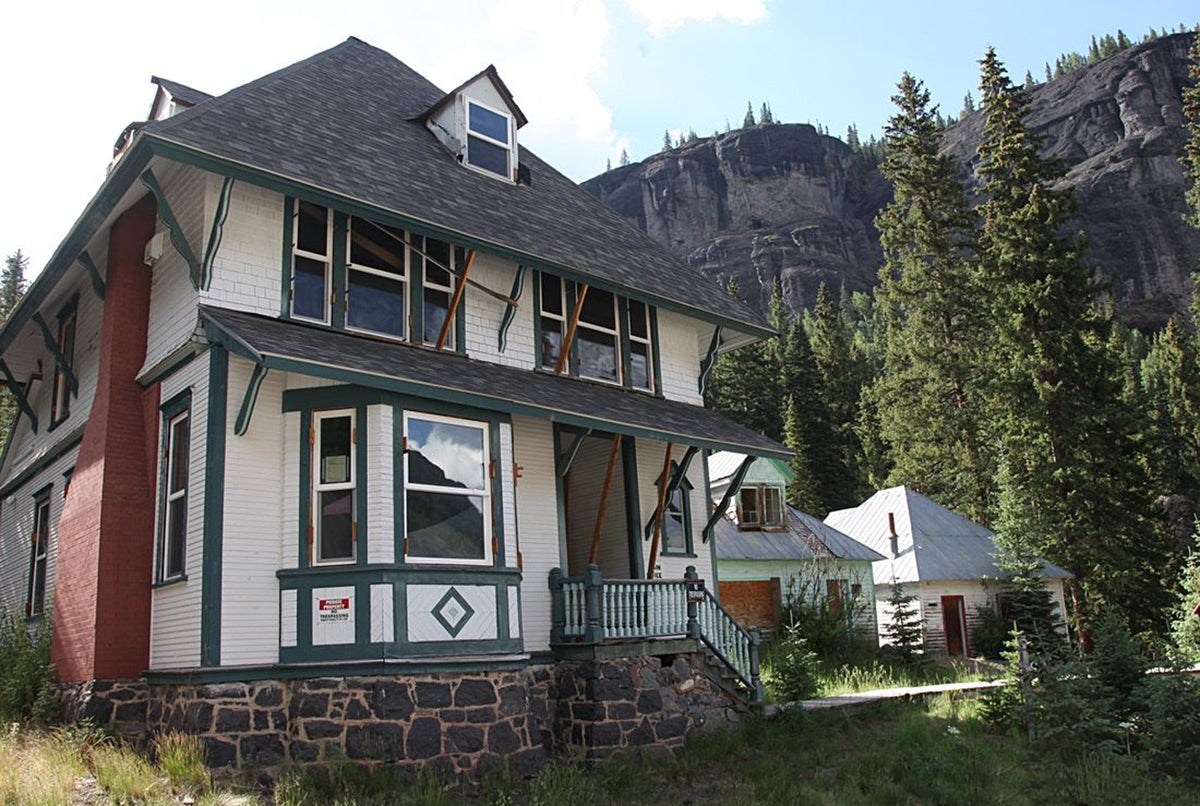
Skiing on a Piece of American History
Every piece of wood tells a story—if you know how to read it. Sandy East, owner of American Antique Lumber in Ridgway who has recently collaborated with Wager Custom to make wood veneer topsheets, knows more about historic wood than possibly anyone in the world.
He will tell you, in a slight charming drawl from his home state of Georgia, about the cherry, white oak, maple, and sycamore lumber that was growing long before Christopher Columbus set sail for the New World. And now, you can have some of this living history in your skis.

An example of an old cattle barn. Photo: UW Madison Library
The wood for the new veneers, some of which is more than 600 years old, comes from old dairy barns, bell towers, and other farm structures all over the South and Midwest, as well as from a mine in Wagner’s backyard. East—a legend around Wagner’s neck of the woods for his climbing, skiing, guiding, and avalanche forecasting—has made a living out of saving these historical materials and giving them a second life as homes, restaurants, and, now, skis.
We caught up with him recently to ask him about his collaboration with Wagner Custom. Here’s what he had to say.
Wagner: How did you get into this business?
East: I was in the climbing, backcountry skiing, avalanche forecasting biz, and I’d been doing that for such a long time, it tricked me into the movie biz. I became a movie rigger, doing technical rigging and alpine safety and avalanche forecasting. Then, when I had my first child, I decided I wanted to be an at-home dad, so I started American Antique Lumber.
The "Patriot Oak" veneer comes from a recycled barn in Ohio.
I saw how recycled wood started to be more popular, and I knew I had access to all this stuff in the South and the Midwest. We started in our garage in Ridgway. I wanted to enjoy being at home watching my kid grow up. When that little baby’s in your hands, you don’t want to miss a minute. But now, my kids are grown so I can go play.
Wagner: How do you choose the lumber you use for Wagner?
East: We don’t choose them they choose us. We might cut into a piece of cherry, and if we see super select pieces of wood that we know we’re going to get a high yield out of, we’ll use those for Wagner. So it’s not until we saw open a timber that we discover the beautiful grain patterns and quality that will work for a topsheet.
The sycamore veneer from Sandy East is highly freckled, which gives it its unique look.
Wagner: How do you know how old the timber is?
East: It’s easy to date the material by the barn. So if you’re taking a barn down that was built in 1801 and you count 600 growth rings, that tree started growing way before Christopher Columbus set sail in 1492. They’re from forests that are called “original growth hardwoods”—which means they’re from the time that Europeans first saw them. Their age is what makes the material so special.
Wagner: What were some of the more memorable structures you’ve reclaimed?
East: We took down a bell foundry south of Columbus, Ohio—a lot of this stuff from these big barns in the Ohio River Valley—that was built 1816. I was in that building for two days in awe of how it was put together. It was all timber framed with peg joinery.… It’s amazing to think about how they did it. It inspires you to read about the history of an area and about the techniques they used.

Two spruce trees had to be removed to protect the historic house at Camp Bird. These trees are now the "Camp Bird Spruce" veneers available on our site.
Wagner: How did you hook up with Wagner Skis?
East: I always knew about Wagner because they’re the finest skis in the world. I introduced myself to Pete [Wagner] and we started talking about making some wood skis. Then, in 2018, I was doing avalanche forecasting for a couple mines outside of Ouray and the Sneffles Creek drainage, and one of them was a famous one called the Camp Bird Mine. There was a beautiful alpine spruce that was around 120 years old that was potentially going to compromise the house. I brought my friends in from Boulder, who are both really experienced climbers and one is an arborist, and all together we were able to drop that tree. And I talked to Pete and we decided to make skis out of it. It was incredible. We have that wood sitting in my lot—it’s listed on the Wagner website as Camp Bird Skis.
For me, being able to make skis from the area where I’ve been skiing and guiding for 40-plus years, that was really special. I got really excited about it. And what we were able to do with the Camp Bird spruce, we started doing with the other full-figured hardwoods.
The "Camp Bird" Spruce wood veneer.
Wagner: What’s next for you?
East: Pete and I are dedicated to the idea of trying to locally source and manufacture his cores as well as topsheets right here with American Antique Lumber. We want to use wood from trees that have been downed in avalanche paths or blown down or diseased or from housing developments. It is such a cool idea for me. I have a cabin in Yankee Boy Basin that I guided out of for 18 years, and the idea of making skis out of that zone to ski in that zone—what an incredible thought that is. Maybe once we figure it out, the heliski ops can take wood from their tenure and make skis out of it. It's a fun project, for sure—I never thought that starting this wood business that I’d come back full circle into my skiing and mountaineering heritage.
Wagner: You’re obviously big on sustainability, as is Wagner Custom. Any other passion projects?
East: American Antique Lumber is really proud to give back to the community. We help build mountain bike trails, and help donate local kids bicycles. It’s real fun to be able to have a business that you can give back from.

Sandy East in his natural environment.
--
Article by Kimberly Beekman
Kimberly Beekman is the former editor-in-chief of the late, great Skiing Magazine (RIP), and a longtime editor of SKI Magazine before that. She currently uses the title of “freelancer” as a beard to ski powder all over the world. She lives in Steamboat, Colorado, with her wonderful daughter and terrible cat.




